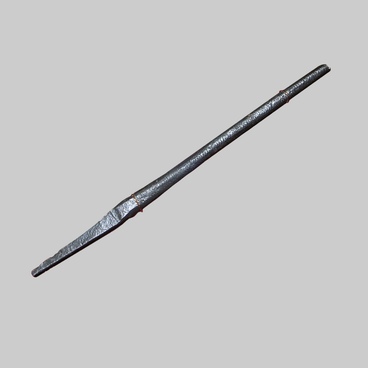While carrying out in archaeological excavations in Kuznetsk ostrog, many iron knives were found. The iron knife in the museum permanent exhibition has a straight back and a wide blade curving towards the cutting edge, partially lost.
Over the entire history of human culture, the knife has always been most common and universal tool. It is most frequently found in excavations. Depending on the technical capacity, the knives were made of silicum, copper, bronze, iron and steel. In Ancient Rus, starting from X century, they were manufactured with a steel thermohardened blade.
Welding knives of two or three metal strips is the most ancient technique. As long ago as end I millennium A.D., based on many centuries of previous experience, high level smithery and thermal hardening techniques were applied to manufacture multilayer knives. That design of a knife was most practical. In the middle of the blade there was a steel strip tempered to form martensite—a very hard form of steel crystalline structure. Due to that, the blade was sharp and firm. Side iron strips on the knife blade made it durable and ductile. Such knife could be used until the blade was grinded off as in any case the cutting edge was made of hard steel.
Economic development and increased sales in 1H XII century the blacksmiths aiming for larger turnout, simplified the knife design, fabrication techniques and started making only the knives with welded blade.
Nikolay Zinyakov, professor of archaeology department of Kemerovo State University, studied in detail the fabrication technique of the knives found during excavations in Kuznetsk. He identified five process schemes: full-steel manufacturing, welding of a steel knife on a soft base, three-layer welding, stack forging and full-orn fabrication. Full-steel knives were made using ordinary chipless shaping of hot metal. To make the blade sharper, various types of tempering were used. Welded knives were good to work with but their manufacturing was more expensive. Full-iron knives were of poor quality: soft edge easily went blunt and the blade twisted.
A soviet historian and archeologist Boris Kolchin developed divided the knives into several categories. A kitchen or household knife is a most common one. Such knives usually had a straight handle: the handle axe was parallel to the straight back of the blade. The handles were made of wood or bone, in most cases with no decorations. Table knives were different from the kitchen ones as they had a larger and longer blade, and higher quality of blade and handle decoration. They were adorned with carving and metal pads. Carpenter’s knives had curved blades and handles, they resemble modern garden knives in shape.
Shoemaker’s knives had a massive wide and short blade with smoothly rounded pointed end, while the combat knives had massive long blades and, as a rule, large bone handles. The combat knife, to the length of 20-40 mm from the end, had a dual-sided cutting and stabbing blade. That is why they were carried in hard leather sheath on the belt, or in the boot shaft, that is why they were also called ‘zasapOzhnik’ (boot knife).
Over the entire history of human culture, the knife has always been most common and universal tool. It is most frequently found in excavations. Depending on the technical capacity, the knives were made of silicum, copper, bronze, iron and steel. In Ancient Rus, starting from X century, they were manufactured with a steel thermohardened blade.
Welding knives of two or three metal strips is the most ancient technique. As long ago as end I millennium A.D., based on many centuries of previous experience, high level smithery and thermal hardening techniques were applied to manufacture multilayer knives. That design of a knife was most practical. In the middle of the blade there was a steel strip tempered to form martensite—a very hard form of steel crystalline structure. Due to that, the blade was sharp and firm. Side iron strips on the knife blade made it durable and ductile. Such knife could be used until the blade was grinded off as in any case the cutting edge was made of hard steel.
Economic development and increased sales in 1H XII century the blacksmiths aiming for larger turnout, simplified the knife design, fabrication techniques and started making only the knives with welded blade.
Nikolay Zinyakov, professor of archaeology department of Kemerovo State University, studied in detail the fabrication technique of the knives found during excavations in Kuznetsk. He identified five process schemes: full-steel manufacturing, welding of a steel knife on a soft base, three-layer welding, stack forging and full-orn fabrication. Full-steel knives were made using ordinary chipless shaping of hot metal. To make the blade sharper, various types of tempering were used. Welded knives were good to work with but their manufacturing was more expensive. Full-iron knives were of poor quality: soft edge easily went blunt and the blade twisted.
A soviet historian and archeologist Boris Kolchin developed divided the knives into several categories. A kitchen or household knife is a most common one. Such knives usually had a straight handle: the handle axe was parallel to the straight back of the blade. The handles were made of wood or bone, in most cases with no decorations. Table knives were different from the kitchen ones as they had a larger and longer blade, and higher quality of blade and handle decoration. They were adorned with carving and metal pads. Carpenter’s knives had curved blades and handles, they resemble modern garden knives in shape.
Shoemaker’s knives had a massive wide and short blade with smoothly rounded pointed end, while the combat knives had massive long blades and, as a rule, large bone handles. The combat knife, to the length of 20-40 mm from the end, had a dual-sided cutting and stabbing blade. That is why they were carried in hard leather sheath on the belt, or in the boot shaft, that is why they were also called ‘zasapOzhnik’ (boot knife).



